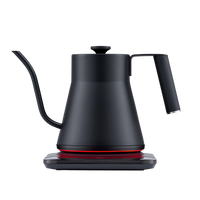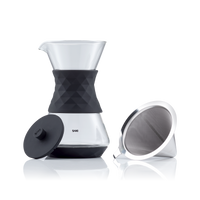what is a samovar? how does a samovar work & how to use one?

Summary: What is a samovar? How does samovar work & how to use samovar? This guide simplifies samovars, explaining their function, use, and care. Learn what a samovar is, how it works, and tips for choosing and maintaining one for your tea rituals.
Whether you're a tea enthusiast or interested in cultural traditions, learn everything about samovars in our latest blog. From the traditional antique samovar powered by coal or wood to the modern convenience of electric samovars, we cover everything you need to know about these iconic tea brewers. Learn how samovars work, what they're made of, history of it and modern trends. Read our comprehensive guide and let the world of samovars inspire your next tea gathering.
What Is A Samovar?
Samovar is a large metal container used to heat and boil water, and to make tea. It has a chimney or pipe running vertically through the middle of the container, where charcoal or wood is placed to generate heat to boil the water. There is also a tap at the bottom of the container to dispense hot water. The teapot used to brew tea is placed upon top, over the boiling water. Due to its design, the samovar keeps the water and tea infusion hot for extended periods, thus creating a warm atmosphere for friendly gatherings while drinking some tea.
Traditional Samovars
The traditional samovar is not just a vessel but a symbol of hospitality and warmth, with a rich history that underscores its cultural significance across various regions. Emerging in Russia during the 18th century, the samovar became an indispensable component of tea rituals and social gatherings, particularly in Eastern Europe.
Samovar literally means “self-boiler” in Russian and it serves as a focal point for communal interaction. It invites family members and guests to gather around, partake in the tea brewing process, engage in meaningful conversations, and share stories. Through this practice, the samovar fosters a deep sense of unity and connection, celebrating the diverse and intricate tea cultures that exist worldwide.
Modern Electric Samovars
In response to the demands of modern lifestyles, electric samovars emerged as a convenient alternative to traditional ones. Electric samovars eliminate the need for charcoal or wood and use electricity to heat the water, eliminating the need for a chimney in the water container. The transition to electric technology has enabled greater efficiency and ease of use, providing a faster and more controlled boiling process.
This innovation also offers benefits such as adjustable temperature settings, automatic shut-off features, and the ability to keep the tea hot for longer periods than traditional samovars and other tea-making appliances. While embracing modernity, electric samovars still retain the essence of the traditional samovar, preserving its aesthetics and cultural significance.
How Does A Samovar Work?
A samovar operation is based on a fairly simple, yet effective principle. Here's a general overview of how it works:
- Structure: A samovar consists of a large metal container for water, with a faucet near the bottom for dispensing the heated water. It has a central tube that runs vertically through the middle, designed to hold burning fuel. This fuel can be solid (like coal or charcoal) or, in modern versions, gas or electricity.
- Heating: The fuel is placed and ignited in the central tube. For traditional samovars, air comes in from the bottom, fuels the fire, and exits through the top, creating a draft that keeps the fire burning. The heat from the burning fuel warms up the water surrounding this tube. In electric samovars, an electric heating element within the tube or at the bottom of the container heats the water.
- Making Tea: On top of the samovar, there's often a small teapot where strong tea concentrate, called "zavarka," is brewed. Instead of being heated directly, the teapot is warmed by the steam or the heat rising from the main chamber of the samovar. This method ensures that the tea stays hot and can be diluted with the hot water from the main container to suit individual tastes.
- Serving: Once the tea is sufficiently brewed, it can be served in a teacup. The tea infusion can be diluted with the hot water dispensed through the spigot at the bottom, creating a hot beverage that can be adjusted for strength according to personal preferences.
How to Use Samovar?
Using a samovar for tea preparation is a ritual that combines tradition with the pleasure of making tea. Here's a simple guide to help you get started:
- Fill the Boiler: Start by filling the samovar's bottom chamber (boiler) with water. Ensure the water level is appropriate for the size of your samovar and the amount of tea you intend to make.
- Heat the Water: Traditionally, samovars were heated with coal or charcoal, but modern versions may use electricity or gas. Turn on the heat source and wait for the water to boil.
- Prepare the Tea Concentrate: While the water is heating, use loose tea leaves to prepare a black tea concentrate in the teapot that sits on top of the samovar. Place loose tea leaves inside the stainless steel filter and add the quantity that suits the strength you desire.
- Brew the Tea: Once the water boils, use a small amount of it to brew the tea in the teapot. Pour enough hot water to cover the loose tea leaves. Let it steep until it forms a rich concentrate.
- Serve: To serve, pour a portion of the tea concentrate into a cup and dilute it with the hot water from the samovar to achieve the desired strength. Adjust the proportion of concentrate to water according to taste.
- Enjoy and Maintain Warmth: The samovar not only brews the tea but also keeps it warm. Enjoy your tea, refilling and adjusting as necessary.
How to Clean a Samovar?
Cleaning a samovar involves several steps, tailored to its material (commonly brass, copper, or silver) and whether it is electric or traditional. Here is a general guide to help you clean your samovar, focusing on traditional non-electric types. For electric samovars, refer to the manufacturer’s instructions to avoid damaging the electrical components.
Materials Needed to Clean a Samovar:
- Soft cloth or sponge
- Warm soapy water
- Baking soda or a commercial metal polish (appropriate for your samovar's material)
- Vinegar (for lime scale removal)
- Lemon (optional for extra shine)
- Soft brush (for detailed areas)
Samovar Cleaning Steps:
- Dusting Off: Start by gently dusting off the samovar with a soft cloth to remove any surface dust.
- Washing: Mix warm water with a mild detergent. Using a soft cloth or sponge, carefully clean the samovar's exterior and interior. Avoid using abrasive scrubbers that can scratch the surface.
- Dealing with Tarnish and Stains: For copper or brass samovars, make a paste of equal parts vinegar (or lemon juice) and salt, or use baking soda and water. Apply the paste to tarnished areas and gently rub with a soft cloth. For silver samovars, use a silver polish. Rinse the samovar thoroughly with warm water after applying these solutions.
- Removing Lime Scale: If your samovar has lime scale buildup inside, fill it with a mixture of half water and half vinegar. Let it sit for a few hours or overnight, then rinse thoroughly with warm water. For a stubborn scale, you may need to gently scrub it with a soft brush.
- Drying and Polishing: After cleaning, dry the samovar immediately with a clean, soft cloth to prevent water spots. Polish with a cloth dipped in olive oil or use a specific metal polish to enhance its shine. For an extra shine on copper and brass, rubbing a cut lemon over the surface before the final polish can be effective.
- Regular Maintenance: To prevent tarnish, regularly dust and lightly clean your samovar. After each use, ensure it’s completely dry before storing.
Additional Samovar Cleaning Tips:
- Always handle your samovar with care, especially older or antique ones, to avoid dents and scratches.
- Test any cleaning solution on a small, inconspicuous area before applying it to the entire samovar.
- For intricate designs, use a soft-bristled brush to gently remove dirt from crevices.
Each samovar might have specific care instructions based on its material and construction, so if you have the manufacturer’s guidelines or can consult with an expert on antique samovars, it is always best to follow those recommendations.
Conclusion
Samovars blend tradition with modern convenience, offering a unique tea experience that connects us to cultures around the world. Whether you prefer the authenticity of traditional samovars or the ease of electric samovars, these tea makers are designed to enrich your tea-drinking moments.
By incorporating an electric samovar into your home, you embrace a piece of cultural heritage while enjoying the practicality needed for modern living. Whether you're a longtime tea enthusiast or new to the ritual, an electric samovar offers a seamless way to prepare tea that is both an art form and a communal experience
Ready to elevate your tea experience? Click here to choose your Electric Russian Samovar today and join the global community of tea lovers!
Common Questions and Answers
Q: What does 'samovar' mean in Russian?
A: The word "samovar" originates from Russian, combining two words: "samo" and "varit". "Samo" translates to "self" and "varit" means "to boil". So, the literal translation of "samovar" is "self-boiler", referring to its ability to boil water for tea independently, without the need for a separate heating source.
This etymology reflects the samovar's design and purpose as a self-contained unit for heating and serving tea, central to social gatherings and tea rituals in Russia and surrounding regions.
Q: How does an electric samovar work?
A: An electric samovar uses electricity to warm up the water in its base. It has a part that heats up, a place to hold water, and controls to set the temperature. You just plug it in and switch it on, and the heater warms the water to just the right heat. After that, you can brew your tea in the teapot that sits on top of the base.
Q: How does a Russian samovar work?
A: A Russian samovar functions by heating water through a central tube, where fuel (traditionally coal, charcoal, or wood) is burned. Modern versions use electricity to heat the water. The heated water is then dispensed from a tap at the bottom, perfect for brewing tea or other hot beverages.
Q: What materials is the Russian samovar usually made of?
A: Traditionally, Russian samovars are crafted from metals like brass, copper, and occasionally silver for more ornate versions. Modern electric samovars often incorporate stainless steel to enhance durability and ease of maintenance.
Q: How quickly does an electric samovar heat water?
A: The time it takes to heat water in an electric samovar can change based on the model and how much water you're heating. But usually, these samovars heat water faster than the old-fashioned ones. Most of the time, it only takes a few minutes to get the water hot enough for making tea quickly.
Q: Do Russians still use samovars?
A: Yes, samovars remain a beloved part of Russian culture and are still used today, especially in traditional settings and during special occasions. The electric samovar has made it more convenient for daily use, continuing the tradition with a modern twist.






